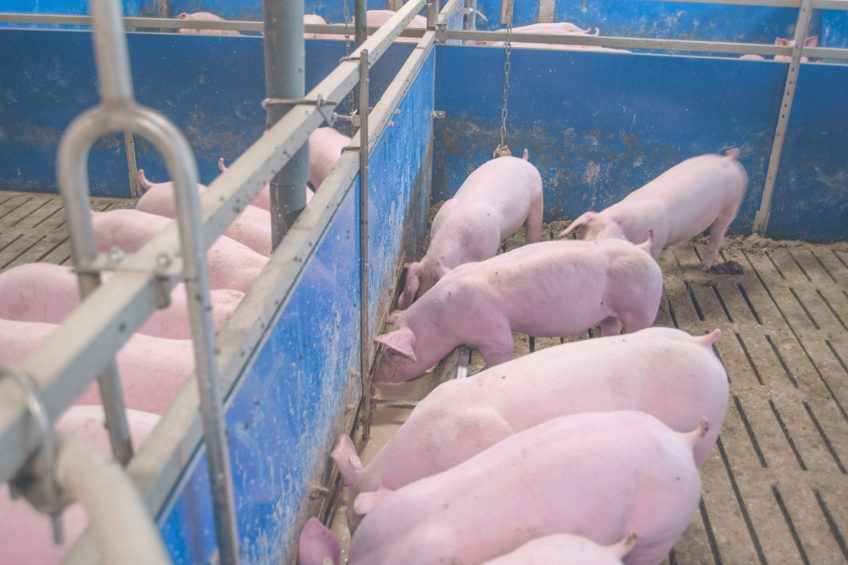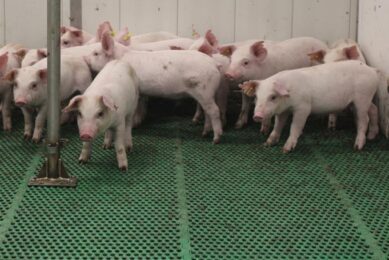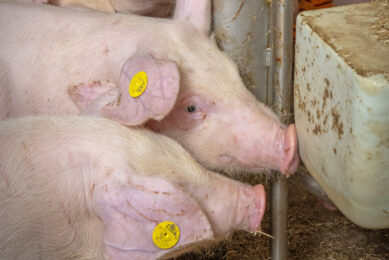Fermented liquid feed on the rise in Germany

Mixing liquid feed with a lactobacilli culture has been on the rise in Germany in recent years. Benefits include an improved gut health, boosted weight gain, feed conversion and profitability. Pig Progress went on-farm in northern Germany to learn more.
Integrated farming is an important key to profitability on the land nowadays. For instance, where home-grown grain goes directly into pigs with a farm shop selling the resultant meat straight to the customer.
Integration can go even further. Take the German Reinke family: Monika and Georg and their son, also called Georg, choose efficient integration of forage maize, biogas, beef bulls and feeding pigs. Maize is the main arable crop on the Reinke farm. And it all goes for silage. The silage feeds beef bulls year-round indoors. The maize forage – along with grass silage – also feeds bacteria for the farm’s large-scale biogas plant, where electricity is produced and sold to the national grid.
|
Warmth generated by the biogas plant is also used. This keeps the pig barns warm, as well as supplying a central heating system for the nearby village of Holtrup, in the state of Lower Saxony. This strategy allows cheaper heating for the pig enterprise which keeps production costs down – and minimises heating bills for the village households. The heat is also used in the newest 2,700-feeding place pig barn (built 2015) as well as supplying it with hot water for a further very modern aspect: a fermented liquid feeding system for the animals, which was installed in 2017.
“It’s too early for absolute figures on performance and health with the fermented feed compared with our unfermented mix fed in the older barns,” explains Georg Reinke Jr. “The claims made for the fermented approach include more efficient feed conversion and lower feed costs. Fermenting the grain in the feed mix means more nutrients and minerals are available in the gut. Better animal health comes from the high quality of the feed, too.”

Sensor-controlled troughs
Mr Reinke Jr continues, “Our pigs, out of PIC sows and by Pietrain (BHZP db 77) boars, are delivered here from a single breeder at 30kg and fed up to 120kg live weight. In the new barn they are grouped 10 to 11 head per slatted pen with sensor-controlled continuous feeding in medium length troughs. We market them through a special animal welfare programme called ‘Tierwohl’ (German for animal wellbeing, ed.) that brings us an extra € 3.50 per slaughter pig because we cut our stocking in the new barn to 2,400 animals. This gives the pigs around 10% more floor space than the legal standard. Other welfare factors in the programme include organic play materials in the pens and more natural daylight in the barn.”
The young farmer continues, “As said, it’s early days yet to define any bottom-line advantages for the fermented feed approach, but it looks like the elevated health and feeding performance brings a good € 3 extra per slaughter pig. Maybe even a bit more.”
How does FLF work?
Explaining just how the fermented feed works is this farm’s pig feeding adviser Dr Ronald Scholten who, under his trademark Dr Ferm, advises farmers, mostly those using Weda liquid feeding systems. Dr Scholten is under exclusive contract as fermentation consultant to the international ForFarmers Group for Germany, the Netherlands, Belgium and the United Kingdom. He developed the concept at the Dutch Sterksel research station in 2002, after completing his doctorate on the subject at Wageningen University in 2001. He explains, “First of all, introducing lactobacilli to a proportion of the grain in pig feed is recognised as effective in lowering pH of the resultant feed mix down to an ideal level for the pig digestion system: 3.6 to 3.9 ideally.”

“What happens – just like in silage – is that the lactobacilli convert glucose in the organic matter to lactic acid. A small amount of acetic acid is also produced which is beneficial because the combination of these 2 acids has a stronger effect than that of either alone. In feed, acidification controls, and often prevents, growth of undesirable pathogens such as coliforms, clostridia and Salmonella. With liquid feed systems where fermented grain is added I always say it is equivalent to the feed being digested in the pig gut for an extra 24 hours. Endogenous enzyme production is also boosted. My work proves the procedure makes nutrients in the feed more available to the growing animals.”
Pig Progress regularly goes on-farm in leading swine production sites across the globe. Check it out
Trial results on FLF
Dr Scholten also points to 2015 trial results from feed supplier ForFarmers which compare feed cost with conventional liquid feed and fermented liquid feed. Use of cheaper raw materials for the fermented feed group meant costs for grower, mid and finisher feeder phase were € 2.16 less per pig. Feed prices were comparatively low in 2015, or this advantage would certainly have been better, says Dr Scholten. Cheaper feed components include rye grain, oilseed rape meal, beet pulp, wheat bran, soy hulls, for example. The advantages of fermenting also allow home-grown protein to be substituted for soybean: maybe protein peas, sunflower seed or field beans. This strategy, for instance, might facilitate a GM-free feed which could suit a targeted non-GM meat marketing programme.
Finally, the fermentation process means that phosphorus (and other nutrients) in feed components can be more readily digested by animals. Result: no expensive diet supplementing with phosphorus (P). Less P thus ends up in manure which is important in further savings realised because farmers can spread more of the manure on their own land. In Europe farmers sometimes have to pay to have pig manure transported off their farms once a certain P quota per hectare has been reached. The higher dry matter (+1 to 2%) of the fermented feed also means that less liquid manure is produced in total. Lastly, P is a finite source mineral. Worldwide, there’s less of it every year.
Better health and less antibiotic use
“Achieving the ideal pH level for pigs means intestinal health is improved,” adds Dr Scholten. “Trials show that diarrhoea is reduced with fermented liquid feeding. Salmonella and E. coli populations are slashed by between 85 and 90%. Trial results prove fermented liquid feed leads to a reduction in pig mortality and in veterinary costs. In European trials, substantial reductions of 75 to 80% are also being recorded for the use of antibiotics and other medicines.”
The entire FLF system is computer controlled and can be externally monitored and adjusted per laptop or even smartphone. That is even noted at a farm level. When Georg Reinke Jr had a fermented liquid feed system fitted in his new barn – at the recommendation of Ronald Scholten – the first feeds were carried out when he happened to be in Rome, Italy, about 2,500 km away. Mr Reinke says, “I was able to follow the whole filling, mixing and feeding operation on my mobile phone. And I could have adjusted any of the feeding valves on the spot if I had needed to.”
Fermented liquid feed: The basicsFarmer interest in liquid feed fermentation for pigs is growing rapidly, according to Ralf Meyer, development manager with Weda. Based in the village of Lutten near Vechta, in Lower Saxony, Germany, this firm is a large pig equipment manufacturer, as well as a global specialist for liquid feeding systems. He says, “Basically, for the liquid fermented feeding systems we market, we have two fermenters. Fermenter tank sizes can run from 5,000 litre capacity to as much as 25,000 litres. For 2,000 feeders you could use two fermenters each of 8,000 litre capacity. One tank is filled with cereals, water and other feed components and the starter culture added for 20-22 hours’ fermentation. Meanwhile, the other tank is emptied over the day and then cleaned. Two adjacent water tanks are required for both systems, one for hot water (kept at about 70ºC), the other for cold.” Feed components wheat, barley, soybean, etc. are mixed with warm water, with cold water added when needed to bring the temperature down. Target final temperature is 38ºC, ideal for active intervention by the added lactobacilli culture. Mr Meyer continues, “After emptying, an automatic alkaline and acid washing system takes over for perfect interior tank cleanliness. The tank must be spotlessly clean so that no remaining bacteria are left to perhaps contaminate the next batch.” Contamination can reduce feed intake for perhaps a day. |
Worldwide monitor for pH levelsWeda feed management aids include a global warning system developed with ForFarmers ensuring efficient running of every registered fermented liquid feeding set-up from the German company. Ralf Meyer, Weda says, “We have contact from our headquarters in Lutten to all registered users. Our system marks the feed pH level of every batch. Where this is consistently correct, the farm gets a green point on our computer score card. Where something goes wrong, the farm can be red-flagged. Every mix tank also features a manual sampling tap so that some liquid feed can be run off every batch for independent tests for dry matter and nutrient consistency.” |


 Profile
Profile








